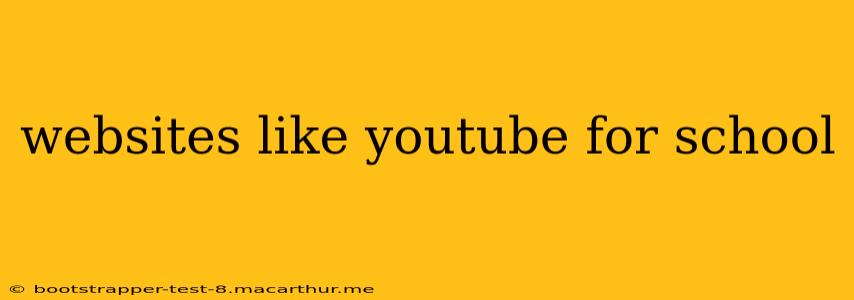YouTube, while a vast repository of information, isn't always the safest or most curated platform for educational use. Its open nature means content can range from highly appropriate to completely unsuitable for a school setting. Fortunately, numerous alternatives offer similar video-based learning experiences with enhanced safety and educational features. This post explores several websites like YouTube for school, catering to diverse learning styles and age groups.
What are some good alternatives to YouTube for schools?
Many excellent alternatives to YouTube exist for educational purposes. The best choice depends on your specific needs and the age group of the students. Some popular options include:
-
Khan Academy: This non-profit organization provides thousands of free, high-quality educational videos covering a wide range of subjects, from math and science to history and art. Its structured approach and focus on clear explanations make it ideal for self-paced learning.
-
TED-Ed: TED-Ed curates engaging and informative animated videos created by educators and animators worldwide. These videos often tackle complex topics in a concise and captivating manner, sparking curiosity and encouraging critical thinking.
-
PBS LearningMedia: This platform offers a vast library of educational videos, interactives, and other digital resources aligned with curriculum standards. Its content is carefully vetted and organized, making it easy to find relevant materials for different subjects and grade levels.
-
National Geographic Kids: Perfect for younger students, this platform provides engaging videos about animals, nature, science, and culture. Its visually appealing content and age-appropriate language make learning fun and accessible.
-
Crash Course: Known for its engaging and informative style, Crash Course offers videos on a diverse range of subjects, from history and literature to biology and philosophy. Its energetic presenters and clear explanations make even complex topics easily digestible.
Are there any free educational video platforms?
Yes, many free educational video platforms are available. Khan Academy, TED-Ed, and PBS LearningMedia are all excellent examples of free platforms offering high-quality, curated content. These platforms are often supported by grants, donations, and memberships, ensuring their continued accessibility.
What educational websites are similar to YouTube?
The similarity to YouTube lies in the video format and the potential for a vast library of content. However, the key difference lies in the curation and safety measures. Platforms like Khan Academy and PBS LearningMedia offer a more structured and curated experience, ensuring content appropriateness and aligning with educational standards, unlike YouTube's open nature.
How can I find safe videos for school online?
Finding safe videos for school requires a proactive approach. Sticking to reputable educational platforms like those mentioned above is crucial. Additionally, always preview any video before showing it to students, ensuring it aligns with your curriculum and is free of inappropriate content. Utilizing the search filters and parental controls offered by many platforms can also help narrow down the search to age-appropriate and relevant results.
What are some alternatives to YouTube for classroom use?
Many alternatives offer features specifically tailored for classroom use. Some platforms offer features like:
- Classroom management tools: Enabling teachers to assign videos, track student progress, and facilitate discussions.
- Curriculum alignment: Ensuring videos align with educational standards and learning objectives.
- Closed captioning and accessibility features: Making the content inclusive to all learners.
Choosing the right platform will depend on the specific needs of your classroom and the available resources. Research different platforms, exploring their features and content libraries, to find the best fit for your educational setting.
By leveraging these alternatives, educators can create engaging and safe learning experiences, harnessing the power of video without compromising on quality, safety, or educational value. Remember to always prioritize the safety and well-being of your students when selecting online resources.
